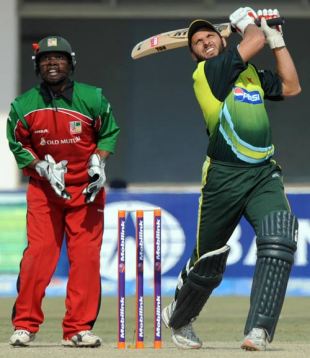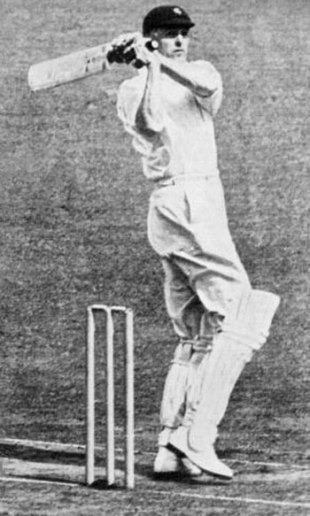More hitting out of the park
A look at another 11 cricketers who enjoyed taking the aerial route

| ||
More than a quarter of his ODI runs (1470 out of 5369) have come in sixes, and in 26 Tests he's thumped 50 more, at a rate unmatched by any of his contemporaries. Shahid Afridi is to big hitting what Luciano Pavarotti was to Top C's. As a 16-year-old in Nairobi in October 1998, in his maiden international innings, Afridi flogged an incredible 11 maximums in a 37-ball century that, to this day, remains unmatched in ODI history. He's approached every subsequent innings as if determined to outdo that moment, which has made for some explosive viewing, not least against his favourite opponents, India, against whom he's made five of his nine international hundreds, including a Test-best 156 at Faisalabad in January 2006.
The first - and so far only - man to record 100 sixes in Test cricket, Gilchrist on song was a sight to behold. Few players in history have struck the ball so sweetly, particularly straight down the ground or in an arc around the front pad and away over wide long-on. His power-hitting zenith came unexpectedly late in his remarkable career, with two extraordinary innings inside four months of each other. At Perth during the 2006-07 Ashes, he slaughtered England's flagging bowlers with a 57-ball century - one shy of Viv Richards' record - including four sixes in six balls to move from a run-of-the-mill 51 from 40 balls to an eye-popping 80 from 46. Then, in the World Cup final, no less, he put the trophy beyond Sri Lanka's reach with 149 from 102 balls. Five years earlier in Johannesburg, he came within a whisker of winning $1 million from a sponsor who had dared any batsman to take potshots at his vast hoarding above the stand at deep midwicket. Eight sixes flew past in an unbeaten 204, and the offer was never risked again.
Whereas WG Grace was a run machine, the man English crowds loved to watch in cricket's Golden Age was Jessop. Among the great batsmen, the most attacking - Frank Woolley and Victor Trumper - averaged 55 runs an hour, while Don Bradman and Denis Compton went at around 45. Jessop's career rate was almost 80. Despite his excellent record, he only once batted for more than three hours and yet five times passed 200. And all this when, for much of his career, a batsman only scored six if he hit the ball out of the ground and not just over the boundary rope. Perhaps the most remarkable thing is that Jessop was only 5'7" tall and weighed around 11 stone. He attacked regardless of the match situation or the bowler - he once admitted he "gambled on a system, a careful system" - and could hit the ball anywhere. His most famous assault came in the final Ashes Test at The Oval in 1902, when he made 104 in 77 minutes, but it was not his most spectacular. That came five years later when he blasted 191 out 234 in 90 minutes at Hastings.
With gum-chewing swagger and trademark maroon cap, Viv Richards didn't need to hit sixes to get his point across, but of course he did so anyway - and with effortless might. In a one-day international at Old Trafford in 1984, he lifted West Indies from 102 for 7 to 272 for 9, with an innings of 189 not out from 170 balls - a torrent of runs the like of which has rarely been equalled even in this era of unbridled strokeplay. Two years later, England were once again his victims and this time his adoring home fans in Antigua were the witnesses, as he belted a 56-ball century that included seven fours and seven sixes. There were never fewer than six fielders on the ropes and sometimes nine, but nothing and no one could interrupt his pageant. Richards was also reputed to be the perpetrator of one of the more visual sledges in the game's history. "It's red, round and weighs about five ounces," said Glamorgan's Greg Thomas after beating him outside off stump a couple of times. "You know what it looks like. Now go and fetch it," retorted Sir Viv, as the very next ball sailed into Somerset's River Tone.
The man who redefined the art of one-day batting, and in doing so, won a World Cup for his country, Sri Lanka. Jayasuriya began his career as a legspinning lower-order batsman, but his promotion to the role of pinch-hitter before the 1995-96 tournament transformed the game forever. Against England at Faisalabad in the quarter-finals, he slogged 82 from 44 balls to put a riposte beyond England's limited ambitions, and he's since pummelled a world-record 247 sixes, with the promise of more to come. With forearms like industrial springs, Jayasuriya has turned the uppercut over point into his stock scoring stroke. Woe betide any bowler who dares to give him width.

| ||
Old-timers are prone to see the world through rose-tinted spectacles, but when I was growing up my grandparents' generation purred over the grace and power of Kent's Frank Woolley. His awesome career stats underline his status as one of the greats of the game - it was said that to be told that you batted like Woolley was the highest praise - but unlike many stylists, he was also a prodigious hitter. He did not clobber as many as Jessop, but when he did, more often than not the ball went vast distances "without any fuss or violence". Against Yorkshire at Bradford in 1931, he bludgeoned 188 in 200 minutes against the leading attack in the land, and in the end the authorities left a man on an adjoining football field to retrieve balls, so many did Woolley deposit there. And at the SCG in 1924-25 he caused a ten-minute delay when he struck Arthur Mailey out of the ground. "At last I've found a way of slowing his scoring-rate down," grinned Mailey as the search for the ball went on.
Wasim's place in the pantheon was booked long ago, thanks to his peerless mastery of left-arm swing bowling - an art that reached its apogee with his match-winning exploits in the 1992 World Cup final. But he was worthy of his place as an allrounder as well, as Zimbabwe discovered to their cost at Sheikhupura in 1996-97. Sashaying to the crease at a perilous 183 for 6, Wasim flogged a world-record 12 sixes in his innings, as well as 22 fours, finishing unbeaten on 257. Unsurprisingly, it was the highest score of his career.
Alletson's career was brief, but he will forever be remembered for less than an hour of mayhem at Hove in May 1909. At lunch, Alletson was 47 not out as Nottinghamshire faced defeat against Sussex and he was given permission to "have a go". As he returned to the middle, team-mate George Gunn called for him to "give the buggers some stick". In the next 40 minutes he scored 142 runs, finishing with 189 out off 227 in 90 minutes. He struck six sixes, including five off Ted Killick, who in one over which included two no-balls conceded 34 runs. Killick said he was unperturbed as long as Alletson did not "lower his sights and hit one straight back at me". His innings ended in controversy when he was caught by CLA Smith at long-off - there seems to have been little doubt that Smith stepped over the ropes as he took the catch, but despite protests, Alletson was given. Five days later he hammered 53 in 23 minutes at Bristol, but thereafter he failed to recapture anything like the same form and soon drifted from the game.
His father, Lance, was a caveman of a cricketer who walked to the crease with a railway sleeper under his arm. The son was a polished chip off the old block - injuries restricted him to 62 Test appearances, but in that time he helped himself to 87 sixes, which remained a world record until Gilchrist and Brian Lara overhauled him. His greatest hits were many and varied: a crunching and series-turning 80 in a low-scoring encounter at The Oval in 1999, a breathtaking 102 not out in the VB Series at Brisbane in 2001-02, and a stylish sign-off against England at Lord's in 2004 - 82 from 47 balls in his valedictory Test series.
Trott is the man who was responsible for one of cricket's most famous big hits when he thumped Monty Noble over the pavilion at Lord's, the only man to launch a six over the massive building. The ball struck a chimney at the back of the roof and fell into a garden. Two months earlier he had straight-driven Sussex's Fred Tate into one of the towers which tops either end of the pavilion - a much bigger hit. Trott, who was a small man, was a genuine allrounder rather than a tail-end slogger, but it is said his famous blow, while playing for Middlesex against the touring Australians, ruined his batting as he was forever more trying to replicate it.
Hammond would be remembered as the greatest batsman of his generation were it not for his misfortune to have a career that ran in parallel with Don Bradman. Whatever Hammond did, Bradman did better ... with one exception. Bradman's risk-free approach meant that rarely did he chance his arm; he only once hit a six in a Test before he had made a hundred, and only hit six in his career. Hammond had no such reservations. He also hit his sixes almost exclusively on the off side, and many eyewitnesses compared his striking with that of a golfer. In 1932 he thumped Hedley Verity for four sixes in five deliveries onto the top of the football stand at Bradford, and playing for England in 1945, by which time he was 43, he peppered the pavilion with three sixes including one which crashed into the roof. In 1932-33 he scored 336 not out, at the time a new world record, against New Zealand, an innings which included another record of ten sixes, eight of which were made on the off side. "I cannot think that human agency could do more to a ball than Hammond," RC Robertson-Glasgow wrote.
Martin Williamson is executive editor and Andrew Miller is the UK editor of Cricinfo